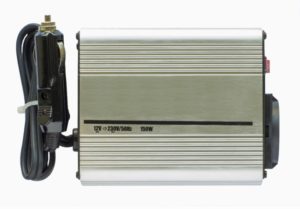When you need a battery badly, you have to make sure it’s good to go. Yet there are times when your battery might be pushing power that is not correct for the device you need to charge. The main job of an inverter is to convert DC power to AC power, which also changes the voltage. The question for many might be, how fast will this process take to drain your battery?
The basic answer here is that without a load to speak of, small inverters can take up 0.1 to 0.2 amps per hour with larger ones taking up to 2.0 amps per hour. Thus, if you leave the inverter on for 24 hours you will lose an average of 1 amp per hour. Complete drainage will depend on the power the battery has, to begin with.
You might ask, why would an inverter even need to drain the battery, right? It’s just converting power from Direct Current to Alternating Current. The issue with this is that AC power is often needed to work at a higher voltage. Therefore, by changing the DC power to AC, you’re going to use up more power.
Of course, most will tell you the cheapest and often most efficient way to draw power from a battery is via the DC system. Yet to understand how all of these batteries work as well as the unit of measurement behind them, you’ll likely need to first know the history behind them.
Table of Contents
Edison vs Tesla: DC vs AC
American Inventor Thomas Edison was the first to use Direct Current. He’d actually end up hiring a young yet impressive European scientist named Nikola Tesla. Of course, Tesla’s job was to go to the numerous DC Power Plants and fix things up.
The real issue with DC is that it might be the most powerful and cheapest way to flow power, but it often cannot travel very far. If we were to only have DC Power Plants today, you’d see a Power Bank every half-mile. We’re totally serious too, as this was pretty much how it was back then for places that did have electricity.
DC also only flows one way. Therefore, whatever it is plugged into will be connected and nothing more. That is why batteries tend to be made to use direct current technology, as you’re charging whatever you connect to it.
AC, on the other hand, can change direction and move around. This allows you to power numerous things at once….such as an entire home. AC is used in your home through your plugs, for example. Allowing you to have lots of things plugged in at once, without any failure to keep their power.
DC vs AC Power:
Tesla knew that was a better way and came up with the idea of an alternating current. This concept led to a huge “Electrical War,” but Tesla’s concept ended up becoming the world standard we use today. Batteries and many chargers utilize a DC form of current, but they do so for obvious reasons.
The issue is that due to DC being such a direct form of power, you have to increase that DC battery’s bandwidth essentially. AC is naturally going to use up more power, as a device needs to power itself in multiple forms. Either that or you need to use AC power to charge or power several things at once.
Inverters come into play when you need this concept to be present. You simply do not need an inverter for most things. Generators and things like this will often even have both AC & DC connections just to make sure you’re getting the charge you need.
Batteries are the main need here, because, again…they tend to always use Direct Current over Alternating Current.
Unit Of Power Used By Batteries
You’ll often see a few forms of power referenced in batteries. The first is “amp” and the other is “mAH.” You’ll often see “Ah” referenced too, so let’s go over what those are. Considering this can be a little complicated, we’ll be sure to explain this thoroughly.
- AMP = Ampere
- mAH= Milliamps Hour
- Ah= Ampere Hour
While it is a long story about how they came to be, all you need to know is that these are classified as something that measures the electromagnetic force between electrical conductors carrying electric current.
Whenever you see AMP on something, you’re seeing how much electric current can run through something at one time. This measures the power of it, as more electricity in an item of a certain size means it can remain powered up longer.
You’ll mostly see mAH and Ah used in your normal, portable batteries. Your regular power bank will tend to use these measurements as they are the easiest way to help us keep up with the power they bring to the table. We’ll explain this more in a bit.
Measurements:
When you’re trying to get down the idea of what something equals out to, you’ll need to know the measurement difference in power between mAH and Ah.
Milliamp Hour has to reach up to 1000 to be one Ampere Hour. Therefore, any product that says Ah on it, will be stronger. Unless the mAh has surpassed it. Essentially, you’ll see either 8Ah or 8,000mAh. They mean the exact same thing.
If you want to throw a monkey wrench into everything, let’s discuss “Voltage.” For products that use voltage as their measurement, you’ll likely see them go from 20V to 100V. At times, batteries you use will have this involved, especially for outdoor equipment that utilizes batteries such as lawnmowers, weed eaters, etc.
There is a small trick you can use to understand voltage strength in amps. Here’s what you can do:
- Multiply The Battery’s Current By How Long It Takes For Voltage To Decrease In Total
- This Will Determine The Rating For A Half-Charge
- Then Multiply That Number By Two, And You’ll Have Your Battery’s “Ah” Rate
As an example, let’s say you have a battery with 12 amps and the voltage reached 12 volts after 10 hours. You’d simply do 12 x 10 x 2. That will give you 240Ah in total. It can sound complicated but all you’re doing is multiplying the average hours your battery or product lasts by the amp, all by two.
The AC vs DC Inverter Efficiency
Your inverter’s “efficiency level” is what tells you how much power you’re losing while converting direct current into alternating current. The average here is usually a power factor of around 1.1, but this can differ slightly.
The best way to determine how much you’re losing is through a mathematical formula. Don’t worry, it’s really easy to do and you don’t need to know Algebra to grasp it either.
AC Power Input / DC Power Input = Inverter efficiency percentage
That’s AC power divided by DC Power. Seriously, that’s all you have to do. Remember to not get the two reversed and you’ll be fine.
To better understand this, your inverter uses up to 90 watts of AC power from 100 watts of DC power coming into it. That results in an efficiency percentage of 90% for you or a “1.11 Power Factor.”
Your Inverter Size Is Very Important

A lot of people forget that you need to get the right size inverter before using one. This is important because of the power you’ll be using. Some might even refuse to work with an inverter if it’s too much.
Yes ladies, sometimes size is a problem!!
You might ask, well how do I know how to choose the right size? Good question! Here are a few good rules to go by:
- Check The Power Consumption On Your Devices (it’s written on them all)
- To Convert Watts To Amps, Use the AMP Formula, which is: Watts/Volts
- To Convert Amps To Watts, Use the Watts Formula, which is: Amps x Watts
- Add 20% To Either Number You’re Seeing
- Now Just Check Your Inverter’s Output Size
This can be a great way of getting the inverter you need. Plus, it can save you money in the long run not to go after something far too expensive for what you really need too. Ultimately, we feel this will be one of the most important steps before buying too.






